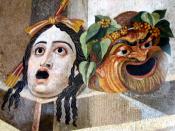Greek theatre took place in large amphitheaters. The actors were a chorus and their leader. There was not multiple characters as we now have today. The leader was the main and only character. At this time the lines were more chanted than spoken. Masks were worn to represent characters and high-soled boots worn to add height to actors.
Greek drama was dominated by the works and innovations of five playwrights for over 200 years. The first three of these wrote tragedies. In these ancient tragedies many new innovations came to light that are still used today in theatre. One was the concept of a second actor, expanding the possibilities for plot and interactions with characters. Then came the third actor which expanded this even more. The role of the chorus in Greek drama shrunk so that the characters could more develop.
The last two Greek playwrights focused on comedies. Throughout the history of theatre, comedies, made up of current standards for humor, have not survived the ages as well as tragedy.
The popularity of these first comedies and the diminishing appeal of tragedy to the audiences of the time, can also be seen as a comment on the role which theatre plays in society at large. Tragedy was at its height in Greek society when that society was at its height. Comedy was most popular during the decline of Greek government
The Romans took much from Greek theatre. Although Roman theatre may not be held in the same high esteem as that of the Greeks, we have inherited much from the influence of the Roman Theatre. One odd example is the word "play" itself, which came from Latin translation of the word ludus, which means recreation or play. Roman theatre had two parts: Fabula Palliata and Fabula Togata. Fabula Palliata...



V good
short,sweet and consise! helped me lots.
1 out of 1 people found this comment useful.